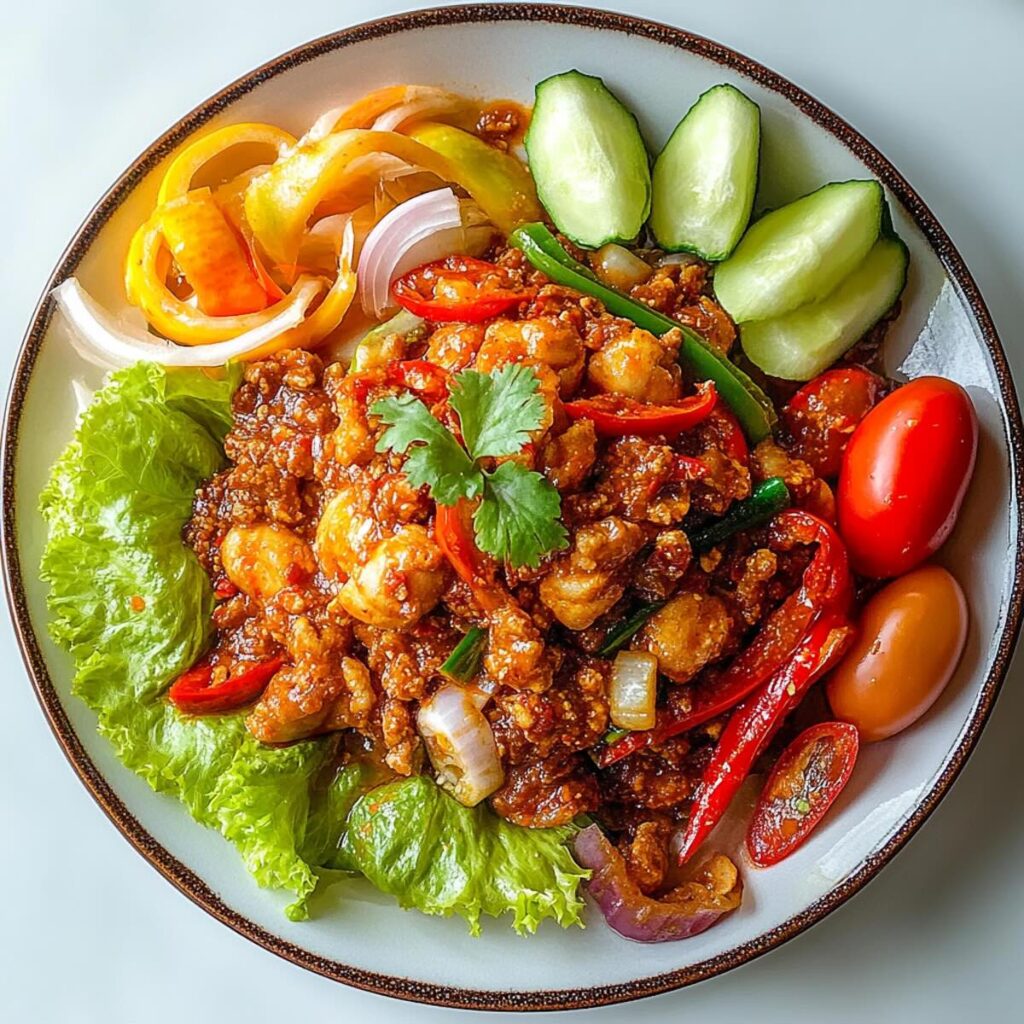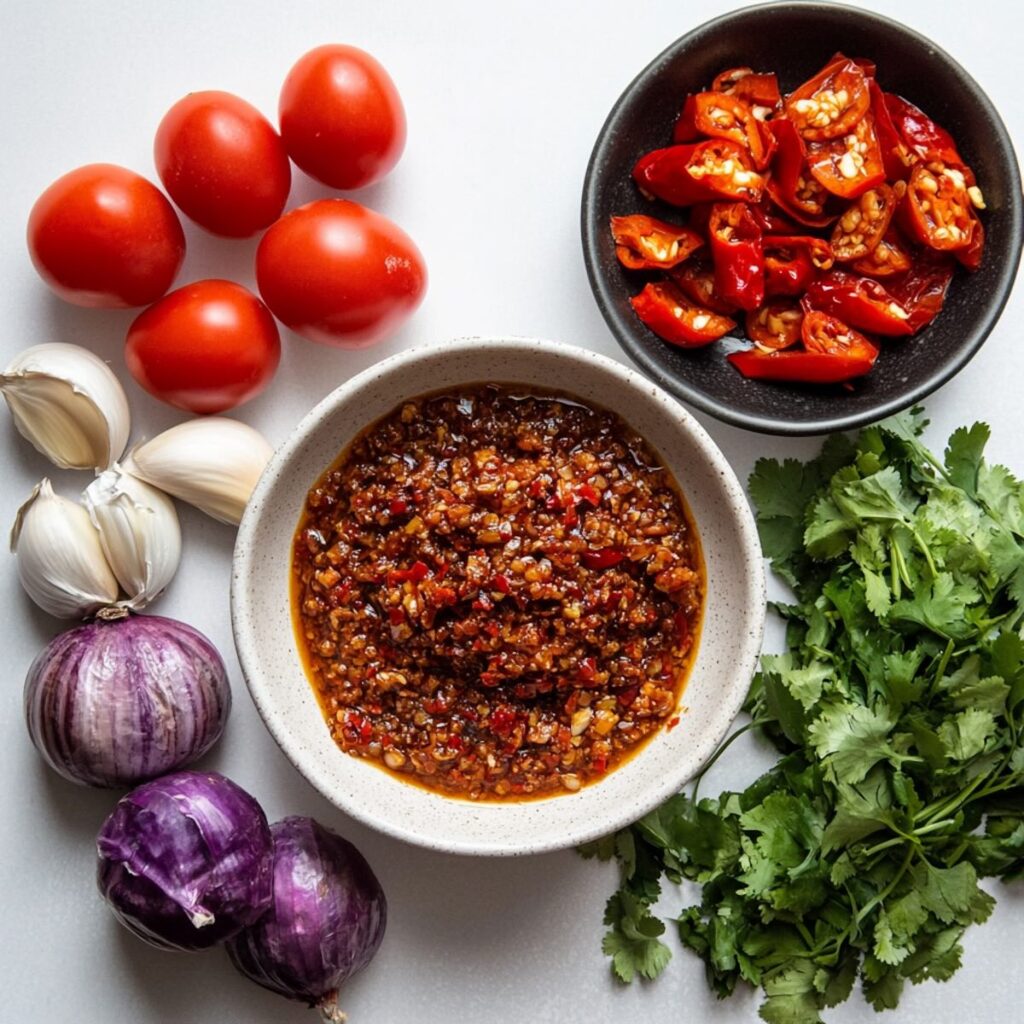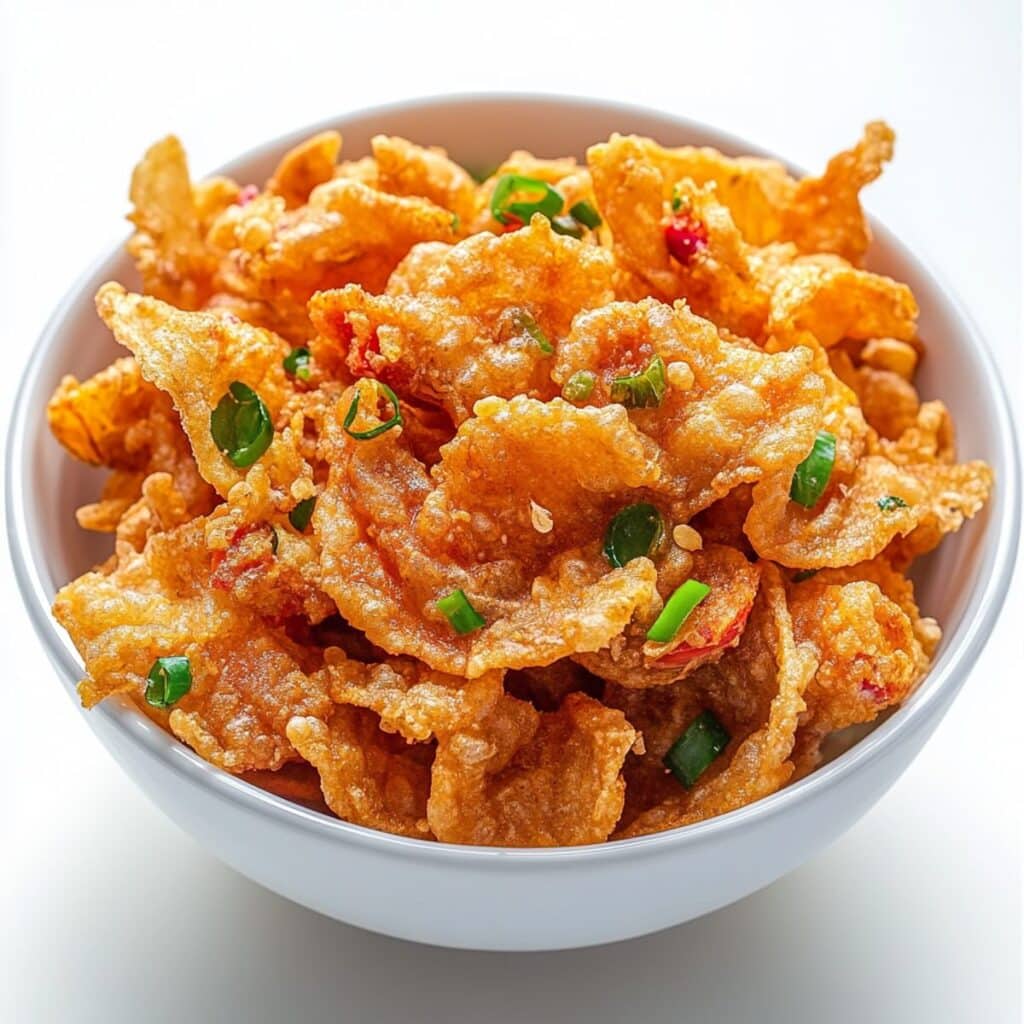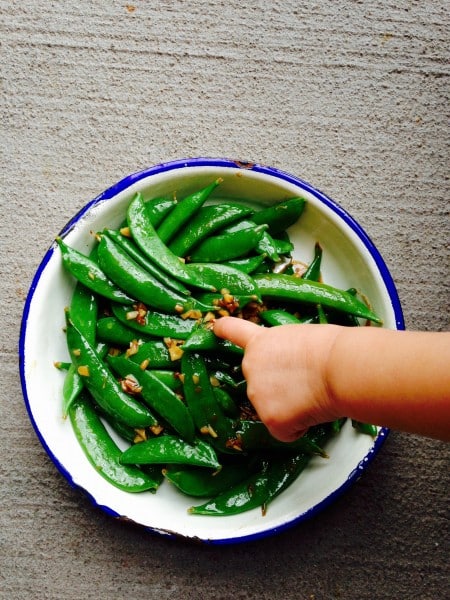
Nam Prik Ong, a life-changing, spicy, sweet, sour pork and tomato Thai stir-fry, perfect for lettuce wraps from my Thai grandma’s kitchen!
Why You’ll Love This Recipe
- LEARN FROM AN EXPERT THAI COOKING CLASS TEACHER: A Thai cooking class instructor (aka me, Sherri! :)) will guide you step-by-step through all the secret techniques to create Nam Prik Ong, a dish straight from grandma’s Thai kitchen to your table!
- EASY WEEKNIGHT CROWD PLEASER DINNER: Nam Prik Ong is packed with authentic Thai flavors, and a unique way to fill up lettuce wraps, which are always a hit at every dinner party!
- USE UP THOSE LEFTOVERS: Got some ground meat, tomatoes, and lettuce in the fridge? Use them up in Nam Prik Ong to transform them into a creative, flavorful dinner!
What is Nam Prik Ong?
Nam Prik Ong is a classic Thai dish from Northern Thailand made with crispy fried shallots, ground pork, tomatoes, tamarind, Thai dried chilies, fish sauce and shrimp paste. It’s often eaten with fresh vegetables or lettuce wraps and steamed jasmine rice.
In Thailand, they don’t have Asian lettuce wraps like you’d find a P.F. Changs, so Nam Prik Ong is one of my favorite ways to create more of a Thai version of a lettuce wrap or my larb lettuce wraps, are another fun fav too of course!
You can eat Nam Prik Ong as a lettuce wraps, but eat it with fried pork skins if you really want to eat it Thai-style!
Sherri’s Story
Nam Prik Ong is one of Thai Hubby’s favorite Thai recipes that his beloved grandma made.

Talk about pressure for me!
Whenever I make Nam Prik Ong, its tantalizing smells of fried shallots, Thai dried chili and garlic, and its sounds of ground pork sizzling in the wok and popping cherry tomatoes, always brings me back like a time machine to Thai Hubby’s Grandma’s house in Sukhothai, Thailand where Thai Hubby’s grandma would make it for us.
At dinner time, in the living room we would roll out Grandma’s worn straw mat on their painted red concrete floor that somehow was always spotless.
Then as those heart-warming smells of fried garlic and shallots wafted in, we would set down a rattling random assortment of pale pink and faded blue plastic plates in a pile, along with well-loved forks and large spoons.
From her outside kitchen, which had concrete floor with wooden beams and a plastic tarp over it, she made her Thai food masterpieces. She had a simple gas powered burner on the ground, with glass bottles of Thai soy sauces lined up in a perfect row next to it.
On a plate, she’d put steamed cabbage, long beans and fried pork rinds with a small bowl of Nam Prik Ong with a starring role in the center of it.
We’d sit around, dipping our crispy veggies in the Nam Prik Ong, savoring its spicy, zesty flavors while watching Grandma’s favorite Thai or Korean soap operas as a large fan lazily spun next to us barely doing anything in its fight against the 110 degrees heat with 100 percent sticky humidity.
Yet the simple, fresh meal and eating it with her was like a magic spell that wafted over us and made us forget about the sweat oozing out our pores in her non-A/C house.
Our Thai Grandma has passed away now, but one of my favorite ways to feel connected to her is through making Thai food like Nam Prik Ong, and reminding our 4 half-Thai kids that the recipe came from her beloved kitchen.
I hope my kids feel as loved and adored through my Thai cooking as Thai Hubby and I did through hers.
Ingredient Notes

- 3 shallots, diced, divided: Adds a mild, sweet flavor that balances the heat of the chilies.
- 2–5 dried Thai chilies: Adjust the spice level to your preference. If you’re aren’t a spicy fan, leave them out.
- 12 garlic cloves, smashed and chopped, divided: Essential for that rich, aromatic base.
- 3 tbsp. cooking oil: Helps to fry up the garlic and shallots to crispy perfection.
- 1 lb ground pork: The main protein of this dish, it absorbs all the delicious flavors.
- 2 c. baby tomatoes, quartered: Adds a sweet and tangy flavor that complements the pork. Feel free to use a quartered large tomato instead.
- 2 tbsp. tamarind paste: Provides that signature sour note.
- 1 tbsp. fish sauce: Adds an umami punch.
- 2 tbsp. brown sugar or palm sugar: Balances out the sour and spicy flavors.
- 2 tsp. Thai Shrimp Paste: Gives a depth of flavor and a hint of umami.
Additions and Substitutions
Uh-oh! Don’t have some of those ingredients I just listed? Don’t worry! Just look below for how to sub them:
- Dried Thai Chilies substitute: fresh Thai red chilies, or fresh or dried cayenne peppers or serrano chiles. Cayenne peppers and Serrano chilies aren’t as spicy, so feel free to add more than the amount you would have added of Thai chili peppers if you still want it spicy.
- Ground Pork substitute: ground beef, ground chicken or ground turkey.
- Thai Shrimp Paste substitute: a little more fish sauce, or anchovy paste, or for a vegetarian or vegan substitute use rehydrated and minced shiitake mushrooms or miso paste
- Baby tomatoes substitute: large tomato quartered
- Tamarind Paste substitute: rice vinegar or lime juice
- Brown Sugar substitute: white sugar or honey in a pinch
- Fish Sauce substitute: 1/2 tbsp soy sauce + 1/2 tbsp vinegar of choice (except balsamic) + a pinch of salt, or coconut aminos.
How to Make Nam Prik Ong: Step by Step
1. Soak the chilies: Start by soaking the dried Thai chilies in warm water for at least 30 minutes to soften them up.
2. Prepare the paste: Add soaked chilies, half of the shallots, and half of the garlic to your mortar and pestle. Pound until smooth. (If you don’t have a mortar and pestle, a food processor works too!)
3. Stir-fry the aromatics: Heat 3 tbsp. of cooking oil in a wok or large pan. Add the reserved garlic and shallots, stir-fry until golden and crisp, then remove them from the pan. Here is a post on how to make crispy fried garlic topping if you need tips!
4. Cook the pork: In the same pan, add the pounded chili mixture. Stir-fry for a few minutes until fragrant, then add the ground pork.
5. Add the tomatoes: Once the pork is partially cooked, add the quartered tomatoes. Crush them slightly to help them combine with the pork.
6. Season: Stir in the tamarind paste, fish sauce, sugar, and shrimp paste. Mix well until everything is evenly coated.
7. Serve: Serve with fresh lettuce wraps, cabbage, green beans, or crispy pork skins if you want to be authentic. If you want to get creative, you can also serve it with chips, crackers, or pita bread for a fun fusion twist.
Recipe Tips & Tricks
- Don’t skimp on the shrimp paste: I know shrimp paste is smelly, but hold your nose and put it in!! If I don’t add enough shrimp paste, that’s the first thing that Thai Hubby notices because that’s really what adds that umami depth of flavor that coats your mouth and makes you want to come back for more.
- Adjust the spice: If you’re cooking for a crowd with varying spice preferences, fry the chilies separately and have them in a dish on the side for those who like spicy to eat alongside their meal. Either they can take a tiny bite of the pepper with each bite, or crumble it up over their serving.
Storage & Reheating
Fridge:
According to the USDA, leftovers like Nam Prik Ong are still good after 3-4 days in the fridge.
Freezer:
You can freeze Nam Prik Ong for up to 3-4 months. Make sure to store the pork mixture and any accompanying vegetables separately.
Reheat:
Reheat the pork mixture on the stove or in the microwave until warmed through. Serve with fresh lettuce or veggies.
Your Questions Answered

What do you eat with Nam Prik Ong?
Serve with fresh lettuce wraps, cabbage, green beans, cucumbers, or crispy pork skins if you want to be authentic. If you want to get creative, you can also serve it with chips, crackers, or pita bread for a fun fusion twist.
Is Nam Prik Ong healthy?
Yes, Nam Prik Ong can be a healthy dish, especially if using a leaner meat like ground chicken or ground turkey, and serving it with an array of fresh vegetables.
What does Nam Prik taste like?
Nam Prik Ong is a Thai chili dip that packed with sweet, spicy, and savory flavors that come from ingredients like Thai dried chilis, palm sugar, tamarind paste and shrimp paste.
Other Recipes You’ll Love
If you make it, I want to see! Take a pic and tag us on Instagram @thaifoodie!
Print
Nam Prik Ong | Thai-Style Lettuce Wraps
- Total Time: 30 minutes
- Yield: 4 1x
Description
Nam Prik Ong, a life-changing, spicy, sweet, sour pork and tomato Thai stir-fry, perfect for lettuce wraps from my Thai grandma’s kitchen!
Ingredients
2–5 dried Thai chilies, depending on spice preference (or you can leave them out and it’s still amazing)
3 shallots, diced, divided
1 head of garlic, cloves smashed and chopped, divided
3 tbsp. cooking oil
1 lb. ground pork
2 c. baby tomatoes, quartered, or large tomato quartered
2 tbsp. tamarind paste
1 tbsp. fish sauce, to taste
2 tbsp. brown sugar or palm sugar, to taste
2 tsp. Thai Shrimp Paste, to taste
Instructions
- Soak the 2-5 dried Thai chilies in warm water for at least 30 minutes to soften them up before their pounding.
- Add the soaked 2-5 dried Thai chilies, half of the 3 shallots you’ve diced and half of the head of garlic to your mortar and pestle.
- Pound until smooth. *If you don’t have a mortar and pestle, you can use a food processor.
- Add 3 tbsp. of cooking oil to a wok or large pan. Add the other half of the reserved garlic and shallots to the cold pan, and turn the burner to medium heat.
- Stir-fry until brown and crisp. Keep stirring it while it fries and once it starts to turn golden, turn off the pan and keep stirring. It can quickly go from brown to burnt if you don’t keep your eye on it. (Check out my post on how to make crispy fried garlic here for more tips).
- Remove the fried garlic and shallots and place in a small bowl, but keep the garlic and shallot infused oil in the pan.
- Now add the paste of pounded chilies, garlic and shallots and stir-fry for a few minutes until fragrant.
- Then add the 1 lb. ground pork and combine well with chile paste mixture.
- When the pork has cooked a little, add the 2 cups of quartered tomatoes.
- Crush the tomatoes with the back of your spatula to help them combine with the pork mixture. Stir until pork is cooked through and combined well with the tomatoes.
- Then add 2 tbsp. tamarind paste, 1 tbsp. fish sauce, 2 tbsp brown sugar, 2 tsp. shrimp paste, the crispy fried shallots and garlic, and mix it up.
- Add more of whatever flavor you want more highlighted. We like ours more sweet and sour with a slight salty taste.
- Serve it with lettuce wraps, steamed strips of cabbage, steamed crispy tender green beans, crispy pork skins, or if you want fusion, serve it with chips, crackers or pita bread!
Notes
- Don’t skimp on the shrimp paste: I know shrimp paste is smelly, but hold your nose and put it in!! If I don’t add enough shrimp paste, that’s the first thing that Thai Hubby notices because that’s really what adds that umami depth of flavor that coats your mouth and makes you want to come back for more.
- Adjust the spice: If you’re cooking for a crowd with varying spice preferences, fry the chilies separately and have them in a dish on the side for those who like spicy to eat alongside their meal. Either they can take a tiny bite of the pepper with each bite, or crumble it up over their serving.
Substitutions:
Dried Thai Chilies substitute: fresh Thai red chilies, or fresh or dried cayenne peppers or serrano chiles. Cayenne peppers and Serrano chilies aren’t as spicy, so feel free to add more than the amount you would have added of Thai chili peppers if you still want it spicy.
Ground Pork substitute: ground beef, ground chicken or ground turkey.
Thai Shrimp Paste substitute: a little more fish sauce, or anchovy paste, or for a vegetarian or vegan substitute use rehydrated and minced shiitake mushrooms or miso paste
Baby tomatoes substitute: large tomato quartered
Tamarind Paste substitute: rice vinegar or lime juice
Brown Sugar substitute: white sugar or honey in a pinch
Fish Sauce substitute: 1/2 tbsp soy sauce + 1/2 tbsp vinegar of choice (except balsamic) + a pinch of salt, or coconut aminos.
- Prep Time: 15
- Cook Time: 15
- Category: Thai
- Method: Stir-Fry
- Cuisine: Thai




Hmm, I think the next thing after Sriracha that I need to invest in is some tamarind paste! I’ve noticed it in a couple of recipes of yours that I really want to try 🙂
Yes! I use tamarind paste all the time in Thai cooking. I make my own tamarind paste by buying a block of seedless tamarind and squishing it to make my paste 🙂 Let me know if you need tips on it!
Hi.
I feel like Thai dips are a really overlooked aspect of Thai cuisine! In Thailand they are common and you can find all kinds but we rarely see them in the restaurants or cooking guides. So it’s great to see one here.
PS: just a heads up. The comments don’t display properly in mobile view. They are a narrow verticle strip.
Yes Martin! I totally agree that they are really a missed out part of Thai cuisine in American Thai restaurants. So glad you enjoy seeing a post about it! And thanks for the heads up about my comments, I’ll figure out what’s up.
Yum!!!